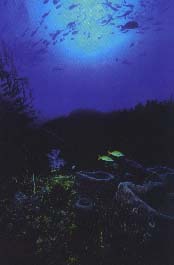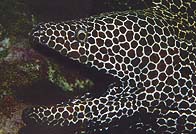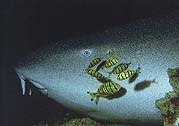Text by Tamara Double, Pictures by Alex Double
 A dense forest of frosty-white thorny coral bushes covers the steep slope of stark, black boulders as far as the eye can see. Dotted amongst the white are brilliant, sulphur-yellow bushes which glow as if electric. Rising through the canopy in wild disarray are clusters of red whip corals, gently swaying in the emerald green water like loosely coiled springs. Dense swarms of yellow fish weave their way through the forest, among them snappers, sweetlips, goatfish and butterflies - all are yellow. In perfect harmony with this colour scheme thousands of pennant fish swirl around, weaving in a mesmeric pattern of spiralling black and white stripes. A leopard ray snakes across a white sand clearing and slips between the black and jagged branches of a massive Tubastrea coral, while a pair of Moorish idols dash by in single file. Overhead, in silhouette, beyond dense schools of batfish and ocean triggers, a squadron of mobulae flies by with bird-like grace. From somewhere in the distance, deep, resonating booms herald the presence of giants, as a colossal jewfish lurches into the depths with a mighty swipe of its tail.
A dense forest of frosty-white thorny coral bushes covers the steep slope of stark, black boulders as far as the eye can see. Dotted amongst the white are brilliant, sulphur-yellow bushes which glow as if electric. Rising through the canopy in wild disarray are clusters of red whip corals, gently swaying in the emerald green water like loosely coiled springs. Dense swarms of yellow fish weave their way through the forest, among them snappers, sweetlips, goatfish and butterflies - all are yellow. In perfect harmony with this colour scheme thousands of pennant fish swirl around, weaving in a mesmeric pattern of spiralling black and white stripes. A leopard ray snakes across a white sand clearing and slips between the black and jagged branches of a massive Tubastrea coral, while a pair of Moorish idols dash by in single file. Overhead, in silhouette, beyond dense schools of batfish and ocean triggers, a squadron of mobulae flies by with bird-like grace. From somewhere in the distance, deep, resonating booms herald the presence of giants, as a colossal jewfish lurches into the depths with a mighty swipe of its tail.
I am diving in the Red Sea, though in an environment so different from the familiar blue water and towering coral reefs which typify the Red Sea that it is hard to believe it is part of the same body of water. The location is the south-western quarter of the Red Sea belonging to Yemen, an area unknown to most and explored by very few. The coast here is flanked by many inshore and offshore islands, volcanic in origin, and ranging in size from mountainous islands, several miles long, to the merest speck of rock, barely exposed above the surface.
Yemen's offshore island chain stretches southward for about 240 kilometres from Jabal at Tair, a solitary lighthouse island lying 80 kms out to sea, at the southern end of the Farasan Bank. From here the chain is split into three main island groups called the Zubair, Zuqar and Hanish. These are barren, uninhabited islands, black and scarred by volcanic eruption and aeons of weather erosion, frequented only by seabirds and local fishermen.
The sea around these desert landscapes, however, is a veritable boiling cauldron of marine life that is outstanding in its abundance and in its unique concoction of species. Because of its proximity to the Indian Ocean this area is undoubtedly influenced by its weather patterns, as well as by the interchange of water between the two seas through the Straits of Bab el Mandeb. Numerous Indo-Pacific species have apparently drifted into the Red Sea with the current and established themselves in this south-western region, among them the Moorish idol, Zanclus canescens, the leopard moray Gymnothorax favageneus and several species of wrasse, fusiliers and triggerfish.
Alongside the immigrant life forms the usual Red Sea species abound
in Yemeni waters, though with some notable exceptions. For instance,
one of the most potent symbols of the central and northern Red
Sea - ubiquitous clouds of Anthias hovering above the reef, feeding
in the current, appears to be totally absent, at least from the
offshore islands. But if this rocky underwater environment lacks
some of the diversity of the living coral reef, it more than makes
up for it with the sheer numbers of fish and the glorious colours
of the encrusting algae, sponges and other invertebrates that
are crammed on to every square centimetre of available rock. It
is an area full of surprises and unusual events. here, some normally
solitary species of fish, such as the half-moon angelfish Pomacanthus
maculosus, can be found in large schools. Huge aggregations of
grazing fishes in a feeding-frenzy are also a common sight, as
are gatherings of several of t he massive groupers known as jewfish Epinephelus itajara.
he massive groupers known as jewfish Epinephelus itajara.
A clue to the enormous wealth and abundance of marine life that is found in the southern Red Sea lies in the cold, nutrient-rich deep water upwellings that occur in this area. The most extreme manifestation of this is during late summer when the upper twenty or so metres are around 33°C and dark brown with phytoplankton. A distinct thermocline occurs at around the 20m. mark, below which the sea is about 10°C cooler and dark but gin-clear. Masses of fish mill around in this soup, engaged in feverish feeding activity. Several unusual fish species, mostly snappers, are seasonal visitors to this scene, often joined by manta-rays and sometimes by whale sharks attracted to the rich planktonic 'soup'.
Nourished by nature's bounty and seemingly untouched by pollution, over-fishing, or mass tourism, these southern reaches are one of the Red Sea's best kept secrets. One can only hope that any plans for the development of this area will include the recognition of its status as a wilderness of outstanding beauty.
Arabian Wildlife. Volume 1, Number 1